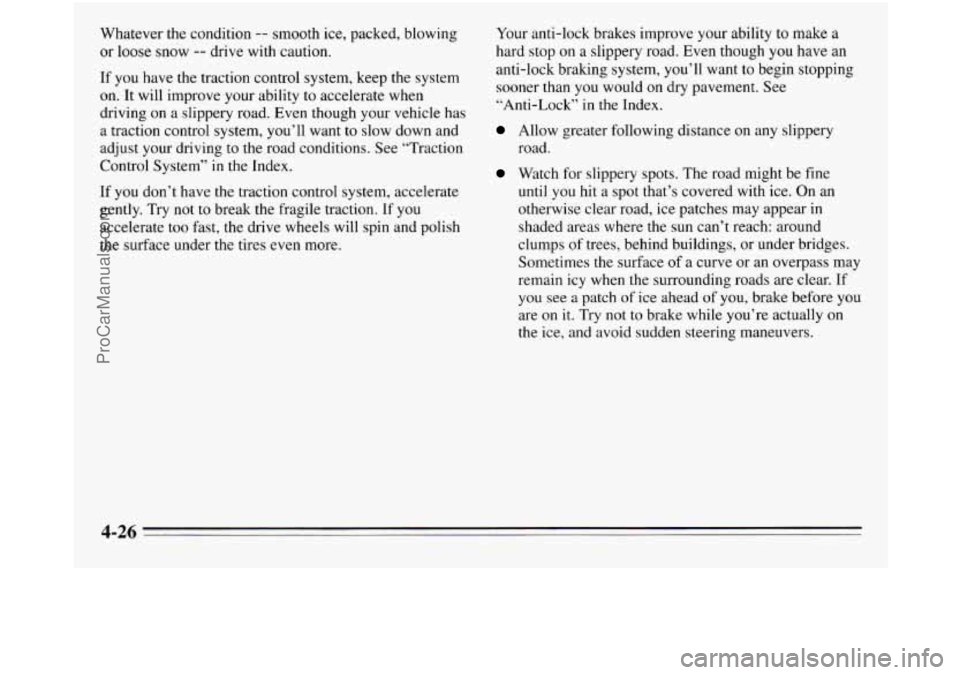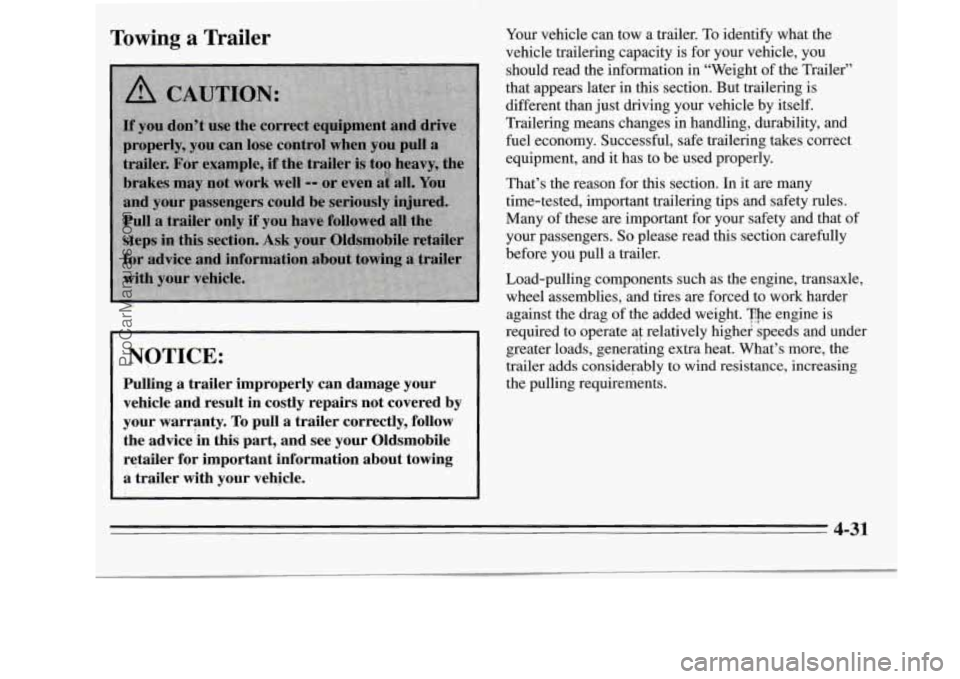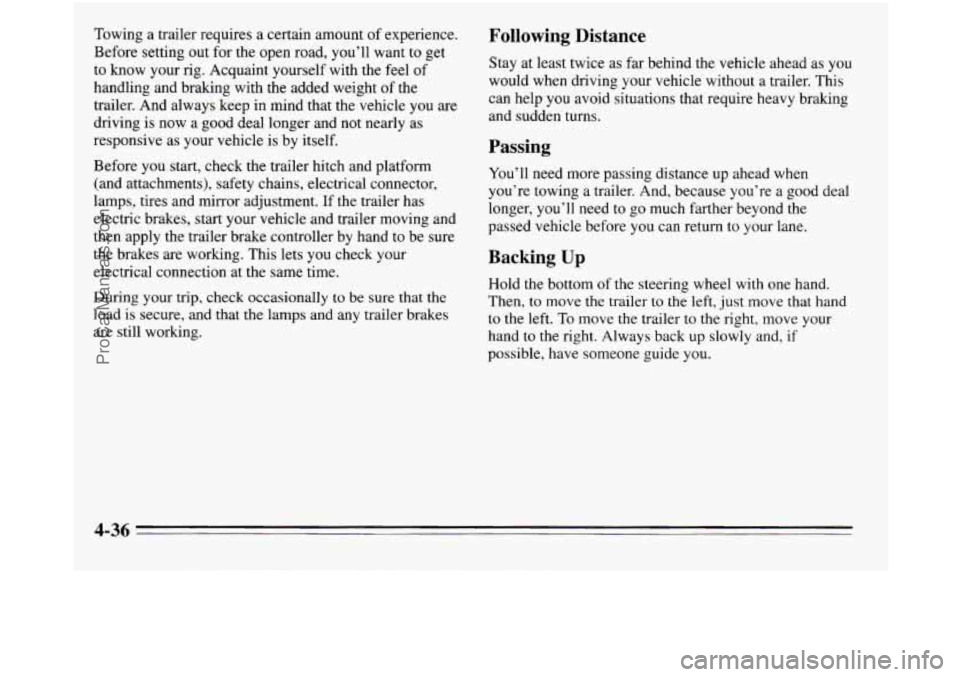Page 208 of 390

Whatever the condition -- smooth ice, packed, blowing
or loose snow -- drive with caution.
If you have the traction control system, keep the system
on. It will improve your ability to accelerate when
driving on a slippery road. Even though your vehicle has
a traction control system, you’ll want to slow down and
adjust your driving
to the road conditions. See “Traction
Control System”
in the Index.
If you don’t have the traction control system, accelerate
gently. Try not to break the fragile traction.
If you
accelerate too fast, the drive wheels will spin and polish
the surface under the tires even more. Your
anti-lock brakes improve your ability to make a
hard stop on a slippery road. Even though
you have an
anti-lock braking system, you’ll want to begin stopping
sooner than
you would on dry pavement. See
“Anti-Lock’ in the Index.
Allow greater following distance on any slippery
road.
Watch for slippery spots. The road might be fine
until you hit a spot that’s covered with ice. On an
otherwise clear road, ice patches may appear in
shaded areas where the sun can’t reach: around
clumps
of trees, behind buildings, or under bridges.
Sometimes the surface
of a curve or an overpass may
remain icy when the surrounding roads are clear.
If
you see a patch of ice ahead of you, brake before you
are on it. Try not to brake while you’re actually
on
the ice, and avoid sudden steering maneuvers.
4-26
ProCarManuals.com
Page 213 of 390

Towing a Trailer
NOTICE:
Pulling a trailer improperly can damage your vehicle and’result in costly repairs not covered by
your warranty.
To pull a trailer correctly, follow
the advice‘in this part, and see your Oldsmobile
retailer for important information about towing a trailer with your vehicle.
Your vehicle can tow a trailer. To identify what the
vehicle trailering capacity is for your vehicle, you
should read the information in “Weight of the Trailer”
that appears later in this section. But trailering is
different than just driving your vehicle by itself.
Trailering means changes in handling, durability, and
fuel economy. Successful, safe trailering takes correct
equipment, and it has to be used properly.
That’s the reason for this section. In it are many
time-tested, important trailering tips and safety rules.
Many of these are important for your safety and that of
your passengers.
So please read this section carefully
before you pull a trailer.
Load-pulling components such as the engine, transaxle,
wheel assemblies, and tires are forced to work harder
against the drag of the added weight. The engine is
required
‘to operate ai relatively highei speeds and under
greater loads, generating extra heat. What’s more, the
trailer adds considerably to wind resistance, increasing
the pulling requirements.
4-31
ProCarManuals.com
Page 218 of 390

Towing a trailer requires a certain amount of experience.
Before setting out for the open road, you’ll want
to get
to know your rig. Acquaint yourself with the feel of
handling and braking with the added weight of the
trailer. And always keep in mind that the vehicle
you are
driving is now a good deal longer and not nearly as
responsive as your vehicle is by itself.
Before you start, check the trailer hitch and platform
(and attachments), safety chains, electrical connector,
lamps, tires and mirror adjustment. If the trailer has
electric brakes, start your vehicle and trailer moving and
then apply the trailer brake controller by hand to be sure
the brakes are working. This lets you check your
electrical connection at the same time.
During your trip, check occasionally
to be sure that the
load is secure, and that the lamps and any trailer brakes
are still working.
Following Distance
Stay at least twice as far behind the vehicle ahead as you
would when driving your vehicle without a trailer. This
can help you avoid situations that require heavy braking
and sudden turns.
Passing
You’ll need more passing distance up ahead when
you’re towing a trailer. And, because you’re a good deal
longer, you’ll need to go much farther beyond the
passed vehicle before you can return to your lane.
Backing Up
Hold the bottom of the steering wheel with one hand.
Then, to move the trailer
to the left, just move that hand
to the left. To move the trailer
to the right, move your
hand to the right. Always back
up slowly and, if
possible, have someone guide you.
4-36
ProCarManuals.com
Page 220 of 390

could start to move. People can be injured, and both
your vehicle and the trailer can be damaged.
But
if you ever have to park your rig on a hill, here’s
how to
do it:
1. Apply your regular brakes, but don’t shift into
PARK
(P) yet.
2. Have someone place chocks under the trailer whe
3. When the wheel chocks are in place, release the
regular brakes until the chocks absorb the load. els.
Parking on Hills
You really should
not park your vehicle, with a trailer
attached, on
a hill. If something goes wrong, your rig
4. Reapply the regular brakes. Then apply your parking
brake, and then shift to PARK
(P).
5. Release the regular brakes.
When You Are Ready to Leave After
Parking
on a Hill
1. Apply your regular brakes and hold the pedal down
while you:
0 Start your engine;
0 Shift into a gear; and
Release the parking brake.
2. Let up on the brake pedal.
3. Drive slowly until the trailer is cl
ear of the chocks.
4. Stop and have someone pick up and store the chocks.
Maintenance When Trailer Towing
Your vehicle will need service more often when you’re
pulling
a trailer. See the Maintenance Schedule for more
on this. Things that are especially important in trailer
operation are automatic transaxle fluid (don’t overfill),
engine
oil, belts, cooling system, and brake adjustment.
Each
of these is covered in this manual, and the Index
will help you find them quickly. If you’re trailering, it’s
a good idea to review these sections before you start
your trip.
Check periodically to see that
all hitch nuts and bolts
are tight.
4-3s
ProCarManuals.com
Page 230 of 390
Towing Your Vehicle
J
I
Try to have a GM dealer or a professional towing
service tow your vehicle. The usual towing
equipment
is:
(A) Sling-type tow truck
(B) Wheel-lift tow truck
(C) Car carrier
If your vehicle has been changed or modified since it
was factory-new by adding aftermarket items like fog
lamps, aero skirting, or special tires and wheels, these
instructions and illustrations may not be correct.
Before you do anything, turn
on the hazard warning
flashers.
5-8
ProCarManuals.com
Page 231 of 390
When you call, tell the towing service:
0 That your vehicle cannot be towed from the front
0 That your vehicle has front-wheel drive.
0 The make, model, and year of your vehicle.
0 Whether you can still move the shift lever.
with
sling-type equipment.
0 If there was an accident, what was damaged.
When the towing service arrives, let the tow operator
know that this manual contains detailed towing
instructions and illustrations. The operator may want to
see them.
5-9
ProCarManuals.com
Page 232 of 390
When your vehicle is being towed, have the key in the
ignition
in the OFF position. The steering wheel should
be clamped in a straight-ahead position, with a clamping
device designed for towing service.
Do not use the
vehicle’s steering column lock for this. The transaxle
should be in
NEUTRAL (N) and the parking brake
released.
Don’t have your vehicle towed on the front wheels,
unless you must.
If the vehicle must be towed on the
front wheels, don’t go more than
35 mph (56 km/h) or
farther than 50 miles (80 km) or your transaxle will be
damaged. If these limits must be exceeded, then the
front wheels have to be supported on a dolly.
5-10
ProCarManuals.com
Page 233 of 390
Towing from the Front -- Vehicle Hookup
Before hooking up to a tow truck, be sure to read all the
information
on “Towing Your Vehicle” earlier in this
section.
I NOTICE:
Do not tow with sling-type equipment or fascia
damage will occur. Use wheel-lift or car carrier
equipment. Additional ramping may be required
for car carrier equipment. Use safety chains and
wheel straps.
NOTICE:
Towing a vehicle over rough surfaces could
damage
a vehicle. Damage can occur from vehicle
to ground or vehicle to wheel-lift equipment. To
help avoid damage, install
a towing dolly and
raise vehicle until adequate clearance is obtained
between the ground and/or wheel-lift equipment.
Do not attach winch cables or J-hooks to
suspension components when using car carrier
equipment.
Always use T-hooks inserted in the
T-hook slots.
5-11
ProCarManuals.com